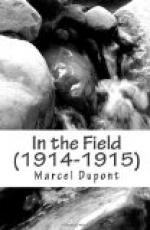This church was an old one, a very old one. Its style was not very well defined, for it had no doubt been built, damaged, destroyed, rebuilt and repaired by many different generations. But those who preserved it to the present day had avoided the lamentable plastering which disfigures so many others. The walls were built with fine large stones, on which time had left its melancholy impress. There was no grotesque painting on them to mar their quiet beauty, and the dim light that filtered through at that early hour gave them a vague soft glow.
No pictures or ornaments disfigured the walls. The “Stations of the Cross” were the only adornment, and they were so simple and childish in their execution that they were no doubt the work of some rustic artist. And even this added a touching note to a harmonious whole.
But my attention was attracted by a slight noise, a kind of soft and monotonous murmur, coming from the altar. The choir was almost in darkness, but I could distinguish the six stars of the lighted candles. In front of the tabernacle was standing a large white shadowy form, almost motionless and like a phantom. At the bottom of the steps another form was kneeling, bowed down towards the floor; it did not stir as I approached. I went towards the choir on tip-toe, very cautiously. I felt that I, a profane person, was committing a sacrilege by coming to disturb those two men praying there all alone in the gloom of that sad morning. A deep feeling of emotion passed through me, and I felt so insignificant in their presence and in the mysterious atmosphere of the place that I knelt down humbly, almost timidly, in the shadow of one of the great pillars near the altar.
Then I could distinguish my fellow-worshippers better. A priest was saying mass. He was young and tall, and his gestures as he officiated were slow and dignified. He did not know that some one was present watching him closely; so it could not be supposed that he was speaking and acting to impress a congregation, and yet he had a way of kneeling, of stretching out his arms and of looking up to the humble gilded cross in front of him, that revealed all the ardour of fervent prayers. Occasionally he turned towards the back of the church to pronounce the ritual words. His face was serious and kindly, framed in a youthful beard—the face of an apostle, with the glow of faith in his eyes. And I was surprised to see underneath his priest’s vestments the hems of a pair of red trousers, and feet shod in large muddy military boots.
The kneeling figure at the bottom of the steps now stood out more distinctly. The man was wearing on his shabby infantry coat the white armlet with the red cross. He must have been a priest, for I could distinguish some traces of a neglected tonsure among his brown hair.
The two repeated, in a low tone by turns, words of prayer, comfort, repentance, or supplication, harmonious Latin phrases, which sounded to me like exquisite music. And as an accompaniment in the distance, in the direction of Saint Thierry and Berry-au-Bac, the deep voice of the guns muttered ceaselessly.




